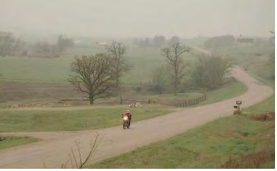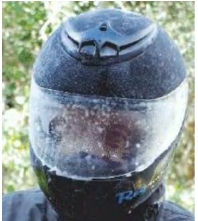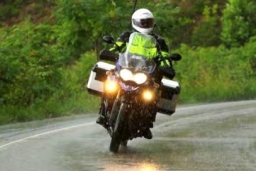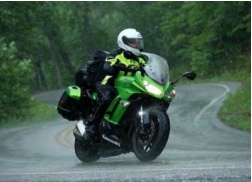Spring has sprung! In many areas of the country Spring riding also means wet riding, but that doesn’t have to mean no riding. With some careful planning and preperation, you can actually enjoy riding in the rain. Don’t believe me? Then read what Mr Parks has to say…..
By James T. Parks
[Editor’s Note: This article is reprinted from the February 2019 edition of the FLMSTA Gator Tale.]
Many, if not most, of us consider riding in the rain a necessary inconvenience when we’re caught out in it while going from point A to point B. The experience is frequently made more burdensome because of inadequate riding gear, reduced vision of scenery and road hazards, loss of traction, increased navigational challenges and fogged glasses and face shield, just to name a few. Often, we discover too late that we forgot to pack defogger, rain mittens or some other item critical to reducing the discomfort and increased risk of riding in the rain. It’s my contention, however, that riding in the rain is often less pleasant than it really has to be, partially because we avoid doing it unless forced to ride in the wet. But like most of motorcycling’s other acquired skills, practice almost always leads to a better riding experience. In that vein, here are my top 10 tips for improving your rain riding proficiency and, yes, even enjoyment:

1. Expect Rain: Even if the sun is out, and there’s not a cloud in the sky before leaving home, expect the possibility of rain during any ride that lasts more than a couple of hours. That means riders should almost always pack rain gear. And, by the way, most textile riding gear that says it’s rain resistant, or even waterproof, usually isn’t in long, soaking rainfall. So, pack your rain gear!
2. Trust Your Tires: One of the biggest phobias of inexperienced riders, once pavement becomes wet, is that their tires will rapidly lose traction. The soft rubber composition of motorcycle tires (especially compared to car tires) means that most of them retain about 80% of their dry pavement traction. The presence of oil, antifreeze or any one of a number of other chemical substances on rain-slick roads, however, can significantly compromise traction. If wet pavement appears to have a reflective sheen, these chemicals may be present.
3. Avoid Plastic Stripes on Pavement: Pedestrian crossings and some other road markings are actually white plastic strips adhered to the pavement. These stripes become slippery when wet. The same is true for metal road surface coverings, tar snakes, wooden planks a railroad crossings and other similar road materials not made of asphalt or concrete. If these hazards cannot be avoided, then ride over them at a right angle, at moderate speed, with the bike perpendicular to the road surface.

4. Treat Your Face Shield: Recently, I was caught in the rain without any treatment for my face shield. The rain accumulated in drops, diminishing my ability to see down the road in what already was a low light situation. I regularly use plastic polish to keep the surface of my face shield slippery, allowing water droplets to be largely blown away by the wind. I’ve used Rain-X on occasion, but it is designed for glass and doesn’t work well on a plastic face shield. It’s a good idea to treat your shield before beginning any ride. If your shield fogs up, don’t open it completely, because that will enable rain droplets to deposit on the inside that are hard to clear without stopping and removing the helmet to do so. Make sure all helmet vents are open and only crack the shield slightly to increase airflow and exhaust condensation.

5. Inspect Rain Gear Integrity: Over time rain gear can lose its ability to repel water. I learned this lesson once, the hard way, when my dated rain gear began leaking during a daylong ride in heavy rain. The combination of riding wet in the wind caused me to lose body heat, become chilled and then sick enough that I couldn’t continue riding the next day. Nowadays I replace worn rain gear regularly and buy suits with heavy gauge material.
6. Be Visible: I will never understand why some OEMs make black rain gear, particularly the jacket. It’s hard enough to see riders in rainy, low light conditions, without making them virtually invisible to human sight. If your rain gear top isn’t especially colorful or visible, wear a high-viz vest on top of it. Because most other vehicles will have their lights turned on in the rain, reflectors also will improve other motorist’s ability to see and avoid you.

7. Slow Down: Although a relatively small amount of traction is lost on clean wet pavement, it still makes sense to ride more carefully in the rain by avoiding: (1) excessive speed; (2) steep lean angles; (3) close proximity to other vehicles; and (4) aggressive stopping maneuvers.
8. Don’t Push Your Luck: It’s one thing to ride in rain, but quite another to ride into a thunderstorm or even a heavy downpour. Because your riding risk factors are already heightened in rainy conditions, know when to get off the road and take shelter. Remember, your rubber tires won’t provide any protection in the event of a lightning strike, and there’s nothing between you and flying debris picked up by high winds. Common sense should tell you when it’s time to “fold ‘em.”
9. Practice: Here’s a radical idea: go riding in the rain, even when you don’t have to! As is true with most other motorcycle riding skills, practice improves ability, confidence and enjoyment of the experience. The same is true for riding in the rain. Practice effective rain riding techniques close to home so they will be second nature when you need them on a road trip.
10. Learn to Enjoy the Experience: The rhythmic pitter-patter of raindrops, while ensconced in a warm dry cocoon, can be both enjoyable and relaxing. It only can be so, though, after mastering tips 1 through 9 above. I’ve heard of some motorcyclists, who enjoy rain riding so much, they actually look forward to rainy days in the saddle.

Long story short, a rainy day doesn’t mean that your two-wheeled adventure has to stop being safe and enjoyable. –James T. Parks
